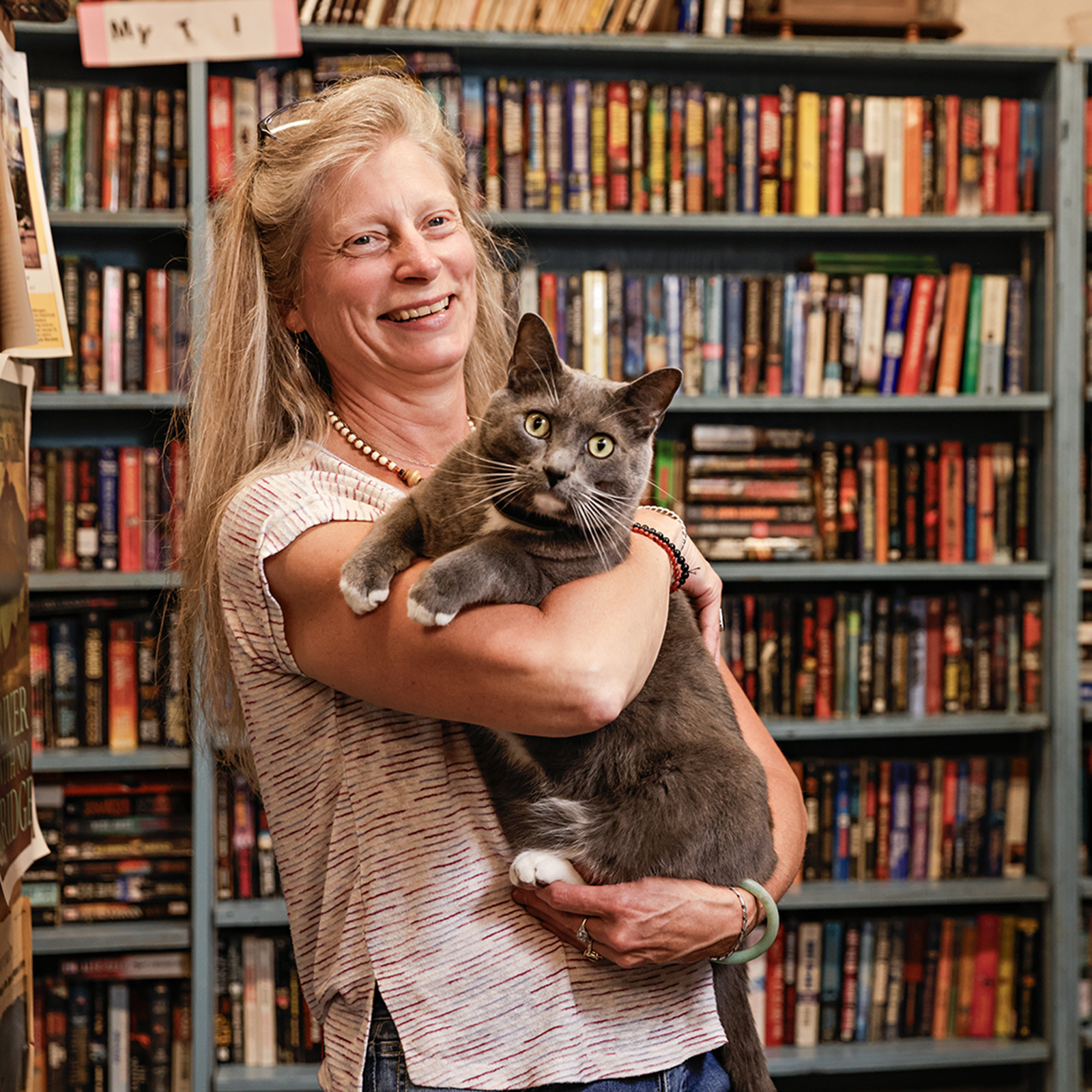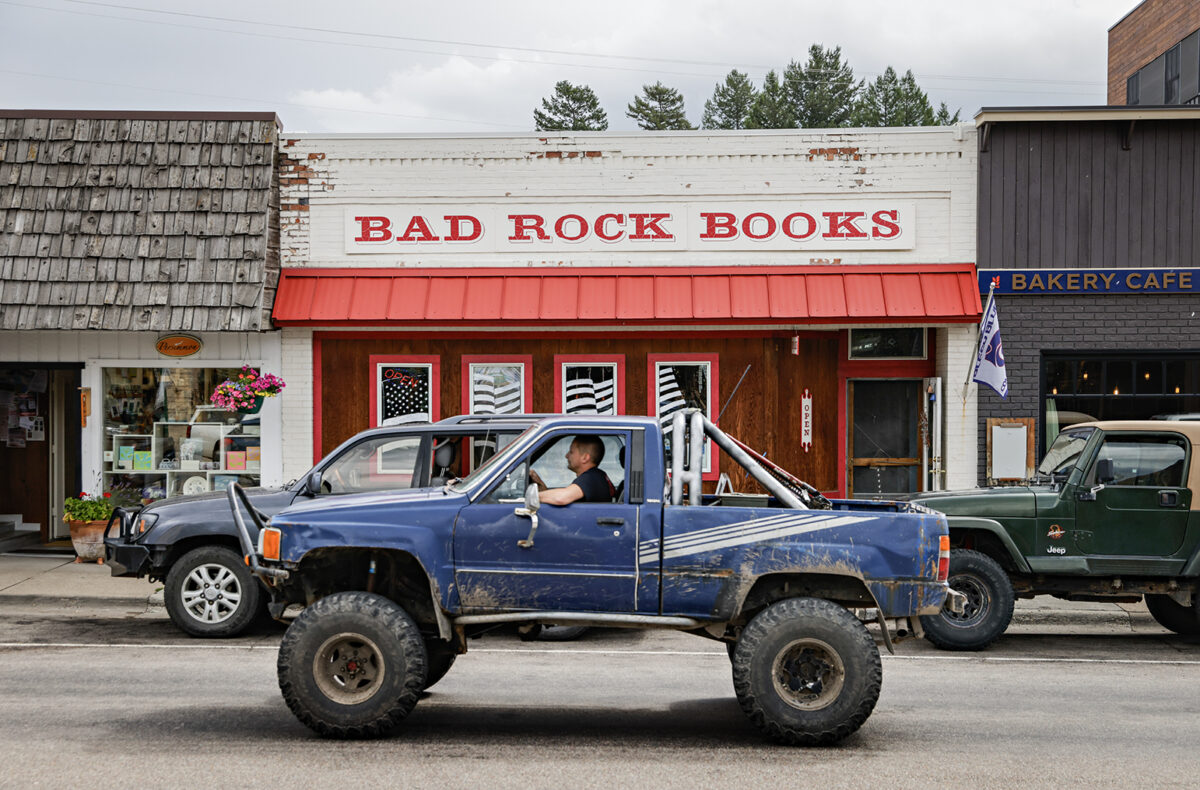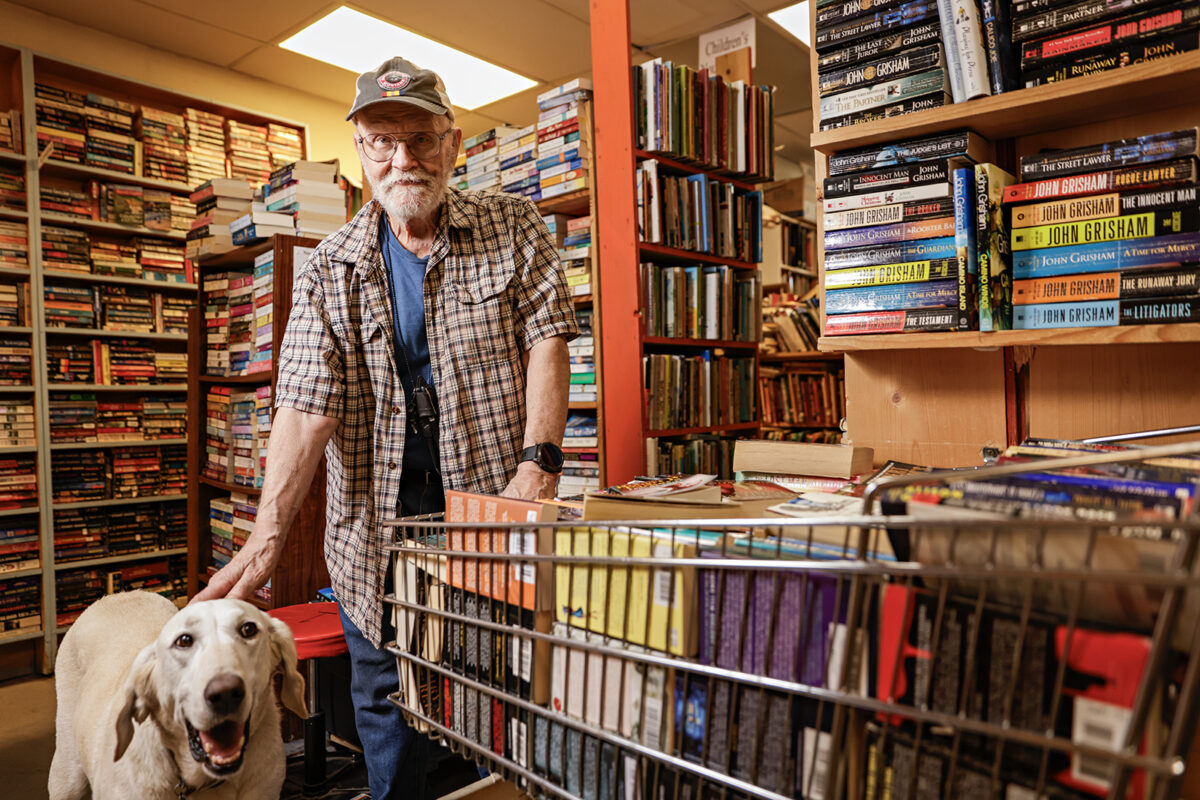
Bad Rock Books
On a Wednesday morning in September, Bad Rock Books in Columbia Falls was packed. Nearly a dozen patrons had dropped into the small shop on Nucleus Avenue in the first 30 minutes since Cindy Ritter unlocked the front door.
Upon entering, customers said a quick hello to Miss Bailey Page Dickens, one of the three shop cats who sits on a table just inside the door waiting for a quick pet.
After greeting Bailey, they spread through the shop, winding around shelves that blanket the walls and fill the store’s three main rooms.
One man beelined it to the cashier’s desk and opened his backpack, unloading one book after another to trade in to the shop. An older couple browsed a section of classics, which Ritter defined as “books I think are important.”
A young girl approached Ritter with two books she’d picked out, accompanied by her father holding his credit card.
“We only take cash or check,” Ritter said as she checked the prices on the used paperbacks.
For a moment, the man hesitated, bereft of cash, but Ritter handed the two books back to the girl. “Don’t worry about it,” she said. “It’s important that kiddos have books.”

The girl beamed and skipped out of the shop, hugging the books tight against her chest.
“I’m the owner here, I can do what I want,” Ritter said. “For people to leave here without a book just because they don’t have money on them, that’s not right. People need books.”
A block and a half away from Bad Rock Books, tucked inside City Hall, is the Columbia Falls branch of the Flathead County Library System. It was there that Ritter wiled away the hours growing up, dreaming of becoming a librarian.
“I realized later I wasn’t going to be able to put in that much time at school to get a library science degree, but I always had the dream. I wanted to help cultivate a love of books,” she said.
Carole Rocks first opened Bad Rock Books back in 1997. Ritter met her a few years later working at the Whistle Stop Café, where Rocks was a morning regular, always ordering a pancake and a cup of coffee. The two became friends and Rocks invited Ritter to help out at the bookstore. In 2010, Ritter started out working one afternoon a week and developed a close relationship with Rocks “until she became my best friend.”
A cancer diagnosis eventually left Rocks in need of additional help and Ritter became more and more involved in the shop while also helping take care of her friend throughout chemotherapy and radiation treatments. In 2016, Rocks passed away and left the store to Ritter.
“I had no idea what was going to happen around here, but I knew the shop needed to support itself,” Cindy said. “It was a huge gift to me, and a huge gift to the community, and throughout the years the community has really just turned out and supported us right back.”
During the COVID-19 pandemic, a water leak carrying a $14,000 price tag almost ended the shop, but local customers launched a GoFundMe campaign and, within two days, they’d raised enough money to cover the expenses.
“It’s the people, the customers and especially our regulars that make this whole thing go around,” she said. “We are tremendously grateful for all the books purchased, all the great conversations and all the incredible kitty love.”
Yes, the kitty love.
The shop cats are vital to the store’s enduring success. Bailey first came to the store in 2011, when Rocks and Ritter found her outside in a window well during the first snowstorm of the year. She immediately became the shop’s mascot, and was soon joined by Miss Poe, a disabled cat with bad knees and a short life expectancy — one she continues to exceed. A third cat, Purrrcy, is large, gray and swaggers around the shop like he owns it.

“The cats are the best advertising I have,” Cindy said. “People will just come in from word of mouth after hearing about the bookstore with the cats. Within three days of Purrrcy’s arrival, before he was even settled in, people were dropping by asking after him.”
Except for the changing furballs and inventory fluctuations, the bookstore has remained essentially unchanged from when Rocks owned it. The genres are largely arrayed in the same spots they’ve always been, especially the front room, which is dominated by a large science fiction and fantasy section, denoted by the sword Excalibur hanging on a wall. Rocks’ husband was big into fantasy novels, and Ritter maintains a robust collection in his honor.
Another holdover from the founder is the analog payment system that eschews credit cards. Customers pay in cash or by check, or with credit accrued by trading in books.
“Some credit holders haven’t been back in the shop in years, but if they ever return, I’ve got an index card with their name on it,” Ritter said. “It’s an especially important system for the locals and for kids — they get their own ‘credit card’ if they trade in books.”
During the pandemic, Ritter started conducting a social experiment — she allowed customers to leave the shop with books in exchange for their promise to mail a check or drop a few dollar bills in the mailbox.
“I’m pretty certain about 95% of those people have paid up over the years,” she said. “We get payment in the mail every day.”
Ritter estimates there are around 20,000 books arranged on the shelves. Books come and go with such regularity it’s near impossible to keep a mental catalogue.
“I used to be an inventory manager at another job, and now I don’t have an inventory at all, which still strikes me as funny,” Cindy said. “Every book that shows up on the doorstep gets to be here. Unless it smells.”
There are a few sections Cindy does make sure to specifically stock. The works of C.J. Box, who writes a series of novels about a Wyoming game warden, are popular requests by customers. Local authors always have a section in a freestanding shelf by the front door. In her classics “and important books” sections, Cindy always has several of her favorites on hand, including “Perma Red” by Debra Magpie Earling, a novel set on the Flathead Indian Reservation in the 1940s. It’s one of the books Cindy will always proffer when asked for a recommendation.
“It’s a tricky thing, curating a collection and guiding people through the store,” she said.
More often, Cindy believes the books choose their reader.
“Books have literally fallen off shelves in front of the people who need them. I can’t tell you the number of times I’ll shelve a book I just got in only to have someone buy it the same day.”
(This author can attest to the phenomenom, having picked up a collection of “The Witcher” novels by Andrzej Sapkowski just hours after they were put on the floor.)
“This store wants people to read, to be informed, to be enlightened. This place has its own mission,” Ritter said. “I’m just the human facilitator.”

Blacktail Mountain Books
Jim Handcock earned his degree in elementary education before very quickly realizing he hated teaching. Instead, he learned that what he truly loves is getting books into the hands of young kids, in hopes of hooking them on reading — just like he was more than 70 years ago.
“Just the other day this family came in and a kid who was probably 5 or 6 suddenly yelled out and picked up a book. His grandma bought him the book, and I know that’s a kid who’s going to read forever,” Handcock said.
Any time kids come into Blacktail Mountain Books, Kalispell’s oldest bookstore, Handcock makes sure they don’t leave empty-handed, often gifting them whatever discovery has piqued their interest.
“I just love seeing kids get excited about books. There’s nothing more important and there should never be a limit on what kids read. If they’re reading comics or graphic novels, that’s great. Anything that can hook a kid on reading should be read.”
And Handcock would know. Long before his friend Jerry Knutson opened the store as a part-time business in the basement of the Kalispell Hotel in 1977, Handcock was the definition of a voracious reader.
Growing up as an only child in the lower Flathead Valley with no neighbors nearby, “books were my escape,” he said. In grade school, his favorite book was “Java Ho!” a Dutch adventure novel about five boys on a sailing ship that wrecks in the East Indies. “My teacher said she could always tell when I was reading that book in class because she could see my face light up. I’ve still got my copy of that book.”
Handcock’s parents were crucial in growing his love for literature, taking him to Kalispell once a week for a visit to the Flathead County library. Handcock would check out the maximum of five books on his library card, then have his mom check out another five on her card. The stack wouldn’t last the week.
“I’d pretty much start reading anything I could get my hands on if I was out of new books,” Handcock said. One summer working for the Forest Service, Jim was stationed in a cabin up the North Fork, relaying messages between fire lookout towers.
“There were no books. I was literally reading soup cans and cereal boxes. I distinctly remember reading a manual on chainsaw maintenance cover to cover,” Handcock said. “Eventually I got an emergency message out to my uncle who worked for the Forest Service, and he and my folks packed in a bunch of books for me.”

Handcock’s lifelong love of reading made the idea of running a bookstore with his friend seem natural, though he never thought he’d still be doing it 45 years later.
Within five years of opening the store, Handcock became the sole proprietor. He hasn’t changed much in the past four decades other than moving the shop to its current location on 1st Avenue West, which allowed the collection to blossom. Several years ago, Handcock tried estimating his inventory and figured there were close to 50,000 books. Now, he’s pretty sure there are “fewer books, but more pages.”
The busy book shop is “really just chaos with a few signs to guide you,” Handcock says. He has no idea what’s contained within the walls. However, asking about an obscure author or specific title will elicit precise coordinates of where to look.
“I don’t know what I have, but I know where what I may or may not have should be,” he said.
Up front, Handcock keeps literary classics, because he thinks they’ve earned their reputation for a reason. He likes when a title like “The Adventures of Huckleberry Finn” catches someone’s eye, leading to an exclamation of “I’ve always wanted to read that!”
The hardcover-fiction and fantasy nook comprises a large number of unorganized tubs and crates — all on wheels for easy maneuvering — as books come and go swiftly through that section. A small stand of newer bestsellers is always popular, unlike the adjacent shelves of cassette-tape audiobooks. A few shelves of foreign language novels move surprisingly well, and a conglomeration of DIY-guides contain vast sums of knowledge — knitting patterns, basic carpentry, plumbing, car repair and more. Among the smallest sections is a smattering of political books, the only topic that earns disapproval from Handcock. “Most politics just end up outside on my ‘FREE’ shelf, because it’s the one subject I hate.”
By contrast, one of Handcock’s favorite sections to keep well-stocked is adventure books, feats of survival, endurance and conquest. They’re among his favorites to read these days.
“I like that they take you to places you’d maybe never go,” he said. “I learned a long time ago; adventure is more fun to read about than it is to have.”
Genres and collections will occasionally shift by a shelf or two as they expand and contract, but Jim refrains from major reorganizations.

“Years ago I switched the sci-fi and mystery sections, just swapped them from one side of the aisle to the other,” Handcock recalled. “I had way too many complaints to ever try doing that again. That kind of thing doesn’t work with book customers, especially repeat customers.”
In the center of the shop sits a well-lit bookcase with glass doors holding a variety of older texts — not quite rare books, but certainly volumes that catch a more discerning eye.
As with many used bookshops, the inventory is mostly provided through donations, estate bequeathals and trades, so historic books will wend through the doors from time to time.
One random, dropped-off box yielded a Dutch book published in Amsterdam back in 1777.
“I wish that book could talk,” he said. “Did it come to Montana on a jet? Did it cross the ocean on a sailing ship? How did it get from there to here?”
The oldest book Handcock currently has in the shop — not for sale, but within reach of his seat at the front counter — is a 1692 first printing of “A Defence of Pluralities, or Holding two benefices with cure of soles as now practiced in the Church of England.”
“I’d like to know how this came here too,” Handcock said. “What has this book seen from its shelves over 300 years?”
In more than four decades, Handcock has never given a thought to closing shop.
“I enjoy the job, I enjoy my customers and I have fun every day,” he said, adding that he only sees, on average, one grouchy customer per year. “People that buy used books are kind of different breed. They just have a good mindset.”
Handcock also believes there’s a smidge of magic, or at least heavy coincidence, at work in the used book business — books seem to end up in the hands of readers who deserve them.
Several years ago, another Dutch book, this one a cookbook published in Holland, came into the shop. Handcock wrapped it up and sent it to a friend of his living near Vancouver whose parents emigrated from Holland at the end of World War II.
“About once a year they send me jelly, or some homemade food, you know, just care packages,” he said. “I sent this book to them as a surprise gift and a few weeks later I got a phone call from my friend asking where I’d gotten the book. It turned out that it was her mother’s cookbook, loaned to a friend more than 30 years ago and never returned. What are the odds of that book coming to Kalispell, to the one person who could get it back home?”